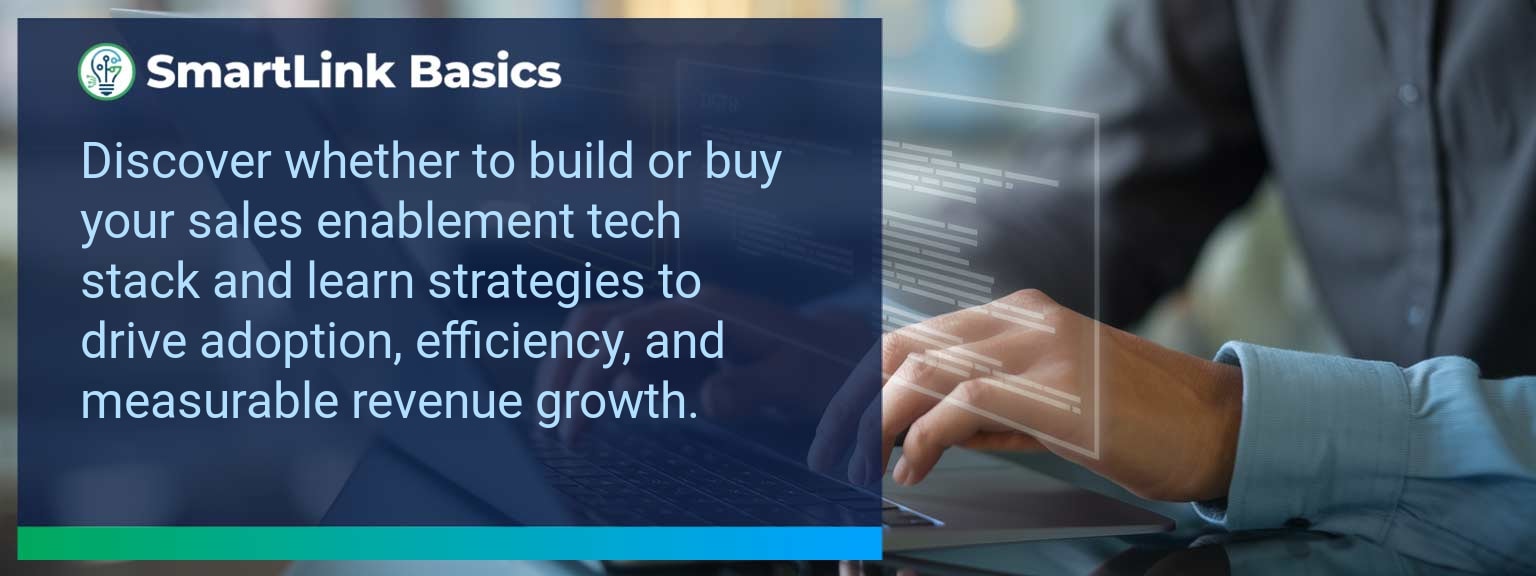Sales teams today are only using about 62% of their enablement tools’ capabilities while paying full price for them. This inefficiency creates real challenges as buying cycles lengthen and revenue operations demand tighter alignment across sales, marketing, and customer success. SmartLink Basics exists to help leaders cut through this complexity by offering frameworks that drive measurable performance results. Making the right decision about your sales enablement tech stack is no longer optional — it’s a revenue-critical choice. In this guide, you’ll learn how to evaluate the “build vs. buy” decision, streamline workflow integration, align with CRM optimization, and apply digital transformation strategies that maximize sales productivity and ROI.
- Sales enablement success comes from adoption, not tool volume.
- Build when proprietary processes or deep CRM integrations matter.
- Buy when speed, scale, or proven workflows are critical.
- Measure Total Cost of Enablement (TCE) beyond software licenses.
- Hybrid strategies using modular platforms with light customization are emerging as the norm.
The Rise of Sales Enablement 2.0 — Smarter Sales Enablement Tech Stack
The most advanced sales organizations are reshaping their enablement ecosystems. Instead of chasing more sales automation tools, they focus on adoption-first platforms that support frontline execution. When tech stacks are overloaded, revenue operations suffer from productivity loss, inconsistent data, and fragmented workflows.
For example, a global SaaS company cut ramp time by 35% by consolidating 14 platforms into a single enablement hub. The shift reduced duplicate logins and aligned content delivery directly in the CRM. The actionable insight: prioritize quality and adoption over feature count.
Redesign the Revenue Operating System with Your Sales Enablement Tech Stack
To effectively choose between build and buy, leaders must rethink their entire operating system around sales enablement. Four levers define success:
ICP, Segmentation, and Targeting
Custom tools can help when ICPs and territories require proprietary data models not served by off-the-shelf vendors. Buying makes sense when you need fast deployment of segmentation dashboards with embedded analytics.
Pipeline Architecture
Smooth workflow integration with CRM optimization is essential. Teams often build unique structures for hybrid sales models, but standard pipeline visualization tools save time when urgency drives the roadmap.
Plays and Messaging
A built platform gives complete control of training material delivery and messaging updates. Purchased tools like Highspot or Showpad excel at scalable, dynamic content routing across buyer journeys.
Operating Cadence
Revenue operations thrive when schedules, coaching touchpoints, and reporting lives in one system. Building can align cadence perfectly to GTM strategy, but buying typically guarantees speed, security, and reliable feature rollouts.
The Complexity of Legacy Tech Stacks
Legacy tech stacks create friction when overlapping tools duplicate work. An average B2B org may run 12–15 sales automation tools, but most sit underused. Performance analytics often show that less than 65% of reps fully adopt these systems. That means wasted spend and lower productivity.
The lesson for sales leaders is clear: evaluate stack optimization annually. Remove redundant licenses and focus on tools that directly contribute to selling motion efficiency.
Smarter Approaches to Build or Buy Decisions
Build when processes are proprietary, integrations are complex, or control of UX influences revenue outcomes. Buy when speed, security, or vendor-driven innovation outweighs customization. Hybrid approaches are growing fastest: starting with a strong platform foundation, then applying modular tools or no-code systems like Zapier for adaptability.
A mid-market financial SaaS firm combined Salesforce and Gong with a Retool dashboard layered on top. The hybrid approach cut manual coaching prep time by 40% while protecting enterprise security requirements.
How Streamlined Tools Impact Sales Performance
When organizations align the right enablement tools with revenue operations, performance accelerates. Benchmarks show 73% faster onboarding and 23% quota lift for teams adopting streamlined ecosystems. The key contributor is reducing friction — giving reps real-time content, clean data from CRM optimization, and guided workflows that support closing deals.
Leaders should track measurable impacts through both leading (adoption) and lagging (quota) metrics. Focusing only on software cost misses the entire performance picture.
The Next Generation of Enablement Technology
The future will favor connected ecosystems, where enablement tools layer seamlessly onto CRM environments and integrate analytics into daily workflows. AI-driven features will drive personalization of coaching, automate administrative steps, and provide adaptive prompts in real time.
Sales leaders should prepare for this shift by simplifying now and architecting tech stacks for agility. Those who balance the build vs. buy decision with a focus on time-to-revenue wins will lead the performance curve.
| Category | Metric | Definition | Target |
|---|---|---|---|
| Leading | Feature Adoption Rate | % of reps actively using core sales enablement features | 75%+ |
| Leading | Training Completion Speed | Time required to complete onboarding or new workflow training | < 21 days |
| Lagging | Quota Attainment | % of reps hitting or exceeding sales targets | 70%+ |
| Lagging | Revenue Per Rep | Average closed revenue per sales professional per quarter | $250K+ |
| Quality | Rep Satisfaction with Tools | Survey rating of usability, efficiency, and effectiveness of stack | 8/10+ |
| Quality | Data Accuracy Rate | Clean and complete CRM data aligned with enablement system | 95%+ |
Get the 90-day plan, coaching rubric, and dashboard template to operationalize AI in your enablement program.
Sales Leaders Must Align Tech Choices With Performance
The build vs. buy decision will define how effectively your sales team executes. The smartest organizations measure adoption, workflow integration, and direct revenue lift before investing. Whether building custom platforms, buying proven tools, or blending both, the ultimate goal is enabling reps to sell smarter and faster. Explore AI-driven sales enablement resources from SmartLink Basics to lead your team into the next era of performance growth.









